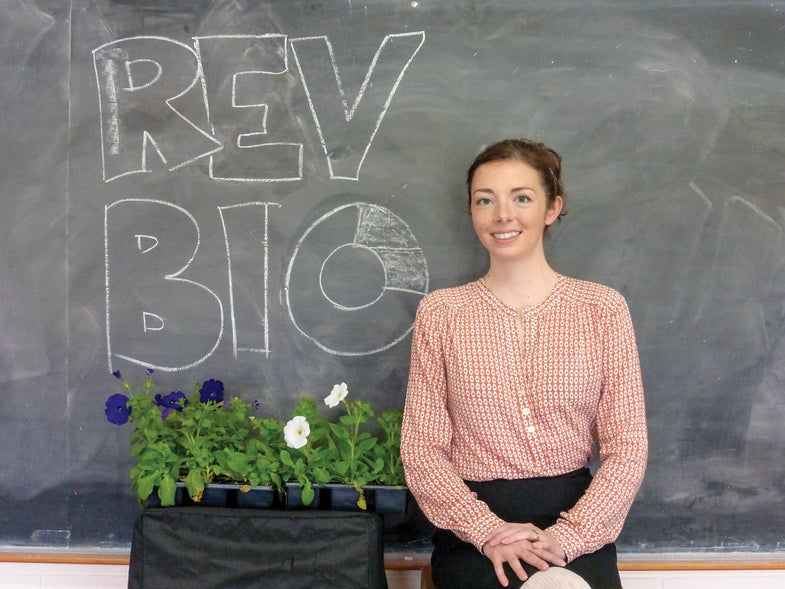How A Former Nuclear Missileer Made A Color-Changing Petunia
Keira Havens went from boom to bloom

From 2005 to 2008, Keira Havens could have started World War III just by turning a key. As a missileer in the United States Air Force 90th Missile Wing, she manned a console that was linked to a battery of nuclear weapons and sealed behind an eight-ton steel door in a concrete bunker 60 feet beneath a missile field.
But Havens’s true interests lay outside the military, with its rigid checklists and strict protocols. By the end of three years, Havens, who has a degree in molecular biology, was ready for a change. “I was interested in doing something on my own,” she says, “answering new questions instead of just reciting things that I had learned.” She joined a University of Colorado biotechnology lab that was genetically engineering plants to change color in the presence of explosives. “One goal was to replace the TSA in airports with a jungle of living sensors,” Havens says.
After this experience, Havens struck out on her own, founding biotech company Revolution Bioengineering last year. With Dutch colleagues, Havens began work on a color-changing petunia, which turns from red to white when watered with a chemical trigger. Eventually, she plans to engineer blossoms that change color throughout the day—hot pink in the morning, deep purple in the afternoon.
Q&A
Popular Science: How did you become a missileer?
Keira Havens: I’m the oldest of four kids. Without an Air Force scholarship, I wouldn’t have been able to go to college. When I [graduated], my degree was in molecular biology and biophysics. The Air Force didn’t have so much of a use for that, so instead they put me into the Space Wing. I got the nuclear missile slot.
PS: Launch facilities have gotten a lot of attention in the press as relics of the Cold War. What did your work entail?
KH: Over the course of a month, you have eight or so alerts. These are alerts for a 24-hour period. You drive to the missile field and you go underground for the 24 hours. They built these rooms underground to be the command and control centers for the nukes. Suspended within a giant concrete egg is a capsule on shock absorbers where you sleep and eat and do your job.
PS: So your job was to play the hand of destruction.
KH: It’s a bizarre little world. It’s got its own dark sense of humor because of that. For example, it says on one of the missile capsule doors: WORLDWIDE DELIVERY IN 30 MINUTES OR LESS, OR YOUR NEXT ONE IS FREE. That’s the Minuteman missile logo on a Domino’s Pizza box.
PS: So how many times have you ended the world?
KH: In training, just about every time. Maybe once a month.
PS: How does someone go from raining destruction to growing plants?
KH: As a missileer, everything is done by the books. There are checklists for every procedure. When I got out of the Air Force, I was really interested in doing something on my own, not proscribed by books, answering new questions instead of just reciting things that I had learned. Engineering biology really appealed to me. I came across a paper by June Medford, a professor at Colorado State University. She’s one of the few people doing plant synthetic biology. I started working for her as an administrator and worked my way back into the lab. When you think about it—food, fiber, fuel, feed—they all come from plants. They are a little bit like magic.
PS: You left the lab to start Revolution Bio last year. Now you’re crowdfunding $75,000 to make petunias that change colors. Is that really possible?
KH: We’re working with Dutch scientist Francesca Quattrocchio of Vrije University, soon to be of the University of Amsterdam, whose work in January 2014 demonstrated how to change a flower from red to blue.
PS: What will your bouquet look like?
KH: The prototype flower changes from white to red. Ideally, I would love to work with a black petunia and have that go from black to white. That would be so dramatic. Our stretch goal for $250,000 is to have continuously color-changing flowers.
PS: You aren’t the first to crowdfund a bioengineered plant project. Glowing Plant raised half a million dollars on Kickstarter. But they’ve encountered controversy in the public and on crowdfunding sites. Has it paved the way for your company, or is it a hindrance?
KH: Glowing Plant broke ground. And that has had consequences for them. They’ve had to deal with regulators and kickback from anti-GMO groups. I hope our markets will be different enough. We’re focusing on moms and grandmas. They’re the ones who are going to make ornamental biotechnology a real and viable thing. Glowing Plant is catering much more to the nerd crowd that wants interesting new technology. My grandmother doesn’t want a quarter-size weed that glows in the dark. She wants petunias.
This article was originally published in the April 2015 issue of Popular Science, under the title “From Nuclear Missileer to Plant Engineer.”